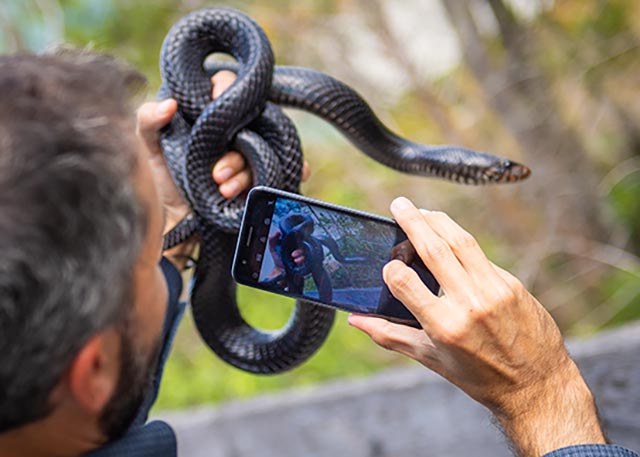Florida Gulf Coast University issued the following announcement on March 30.
Imagine being bitten by a snake. In the moments of chaos that might ensue, the snake slithers back into the bushes and you are rushed to the hospital. Would you know what kind of snake bit you? Would you remember what the reptile looked like?
If your answer to either question is “no,” you’re not alone. But, these are questions healthcare workers must answer as they determine a course of treatment. And they aren’t uncommon. There are over 500,000 snakebite encounters worldwide each year.
“Snakes are diverse across the world. A lot of them look similar to each other, so it can be really hard to tell them apart,” explained Andrew Durso, assistant professor in the Department of Biological Sciences at FGCU. “Most snakes can’t hurt you, but 20% of snakes worldwide are venomous.”

RELATED STORY
» An FGCU undergrad’s Peruvian research adventure
As a postdoctoral researcher at the University of Geneva in Switzerland, Durso joined a team to develop Snake ID, an algorithm to automatically identify snakes in photos.
“We wanted to make one tiny contribution and make it easier for doctors and patients, or anybody involved in the treatment of a snakebite, to correctly identify the snake involved,” said Durso. “In some cases that might influence the treatment that you give. Different anti-venoms are specific to different types of snakes.”
Think of the algorithm like the game Shazam, the app that listens to a certain song and identifies the name and artist within seconds. Snake ID allows a person to upload a photo of the reptile and add the location where it was taken. The program will then comb through what it has learned from studying more than 725,000 photos and generate a ranked list of possible snake species.

Durso joined a team to develop Snake ID, an algorithm to automatically identify snakes in photos.
Part of the algorithm’s success is owed to the human eye and crowdsourcing to help identify snakes from photos.
“One big way we tested these algorithms is that we compared them to the performance of people. We did that by asking people on the internet to help us identify snakes,” explained Durso. “We compared the performance between the two. The punchline: the computer version is better in some circumstances, but humans are still better in other circumstances.”
This is timely research. The World Health Organization (WHO) launched a strategic plan in 2019 to decrease the number of deaths and disabilities caused by venomous snakebites by half by 2030. Durso and his colleagues hope to help the WHO meet its goal while advancing the technology. The next step in their journey to improve treatment options for snakebite victims is turning the Snake ID algorithm into a mobile app.
Another goal of the research is to create better epidemiological data on snakebites.

King, an eastern indigo snake, is an FGCU wildlife ambassador.
“We don’t know which species of snakes are biting people in many parts of the world because it rarely gets recorded and reported,” explained Durso.
The research is an international effort made up of a core team of people in different parts of the world. In 2017, Isabelle Bolon, a veterinarian and researcher with the Institute of Global Health at the University of Geneva, reached out to Durso after seeing he was one of the administrators of the Facebook “Snake Identification” group. The online forum contained a large volume of photos and identifications. Durso joined the Institute of Global Health in 2018.
“His expertise and experience in herpetology, snake identification, and his global network have opened unique opportunities for snake photo gathering,” explained Bolon. “Thanks to his contribution, we were able to build a massive and global photo repository of venomous and non-venomous snakes gathering existing images from museums, personal collections, and open online biodiversity platforms based on citizen science and crowdsourcing.”
In the more than 725,000 photos, 3,000 species of snakes are represented. There are still 781 photo-less species on their “most wanted” list. The team encourages citizens, naturalists and photographers to submit photos and data, especially those species that are missing, to online archives including The Reptile Database, iNaturalist and HerpMapper.
- Explore the Snake ID program
Original source can be found here.



 Alerts Sign-up
Alerts Sign-up